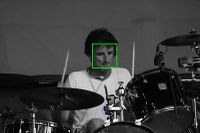Pattern recognition
Pattern recognition is "the act of taking in raw data and taking an action based on the category of the pattern"[1]. Most research in pattern recognition is about methods for supervised learning and unsupervised learning.
Pattern recognition aims to classify data (patterns) based either on a priori knowledge or on statistical information extracted from the patterns. The patterns to be classified are usually groups of measurements or observations, defining points in an appropriate multidimensional space. This is in contrast to pattern matching, where the pattern is rigidly specified.
Contents |
Overview
A complete pattern recognition system consists of a sensor that gathers the observations to be classified or described, a feature extraction mechanism that computes numeric or symbolic information from the observations, and a classification or description scheme that does the actual job of classifying or describing observations, relying on the extracted features.
The classification or description scheme is usually based on the availability of a set of patterns that have already been classified or described. This set of patterns is termed the training set, and the resulting learning strategy is characterized as supervised learning. Learning can also be unsupervised, in the sense that the system is not given an a priori labeling of patterns, instead it itself establishes the classes based on the statistical regularities of the patterns.
The classification or description scheme usually uses one of the following approaches: statistical (or decision theoretic) or syntactic (or structural). Statistical pattern recognition is based on statistical characterizations of patterns, assuming that the patterns are generated by a probabilistic system. Syntactical (or structural) pattern recognition is based on the structural interrelationships of features. A wide range of algorithms can be applied for pattern recognition, from simple naive Bayes classifiers and neural networks to the powerful KNN decision rules.
Pattern recognition is more complex when templates are used to generate variants. For example, in English, sentences often follow the "N-VP" (noun - verb phrase) pattern, but some knowledge of the English language is required to detect the pattern. Pattern recognition is studied in many fields, including psychology, ethology, cognitive science and computer science.
Holographic associative memory is another type of pattern matching where a large set of learned patterns based on cognitive meta-weight is searched for a small set of target patterns.
Uses

Within medical science, pattern recognition is the basis for computer-aided diagnosis (CAD) systems. CAD describes a procedure that supports the doctor's interpretations and findings.
Typical applications are automatic speech recognition, classification of text into several categories (e.g. spam/non-spam email messages), the automatic recognition of handwritten postal codes on postal envelopes, or the automatic recognition of images of human faces. The last two examples form the subtopic image analysis of pattern recognition that deals with digital images as input to pattern recognition systems.[1][2]
See also
- Compound term processing
- Computer-aided diagnosis
- Data mining
- List of numerical analysis software
- List of numerical libraries
- Machine learning
- Neocognitron
- Predictive analytics
- Prior knowledge for pattern recognition
- Template matching
References
Further reading
- Fukunaga, Keinosuke (1990). Introduction to Statistical Pattern Recognition (2nd ed.). Boston: Academic Press. ISBN 0-12-269851-7.
- Bishop, Christopher (2006). Pattern Recognition and Machine Learning. Berlin: Springer. ISBN 0-387-31073-8.
- Koutroumbas, Konstantinos; Theodoridis, Sergios (2008). Pattern Recognition (4th ed.). Boston: Academic Press. ISBN 1-59749-272-8.
- Bhagat, Phiroz (2005). Pattern Recognition in Industry. Amsterdam: Elsevier. ISBN 0-08-044538-1.
- Hornegger, Joachim; Paulus, Dietrich W. R. (1999). Applied Pattern Recognition: A Practical Introduction to Image and Speech Processing in C++ (2nd ed.). San Francisco: Morgan Kaufmann Publishers. ISBN 3-528-15558-2.
- Schuermann, Juergen (1996). Pattern Classification: A Unified View of Statistical and Neural Approaches. New York: Wiley. ISBN 0-471-13534-8.
- Godfried T. Toussaint, ed (1988). Computational Morphology. Amsterdam: North-Holland Publishing Company.
- Kulikowski, Casimir A.; Weiss, Sholom M. (1991). Computer Systems That Learn: Classification and Prediction Methods from Statistics, Neural Nets, Machine Learning, and Expert Systems. Machine Learning. San Francisco: Morgan Kaufmann Publishers. ISBN 1-55860-065-5.
External links
- Introduction to Pattern Recognition using Mathematica
- More on Pattern Recognition using Mathematica
- The International Association for Pattern Recognition
- List of Pattern Recognition web sites
- Journal of Pattern Recognition Research
- Pattern Recognition Info
- Pattern Recognition (Journal of the Pattern Recognition Society)
- International Journal of Pattern Recognition and Artificial Intelligence
This article was originally based on material from the Free On-line Dictionary of Computing, which is licensed under the GFDL.